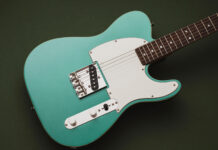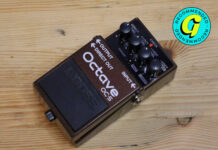
DIY: How to convert an Epiphone Flying V to 1950s spec (Part Two)
The first part of this Flying V upgrade project ended with the body ready for spraying and the post holes plugged. But before donning the breathing mask, there are a few things I need to do. The first is to refret the guitar using wire that’s close to 1959 spec. Original frets on a 1958 Flying V would have been thinner, but the gauge chosen by our guitar’s owner is still a lot skinnier than Epiphone’s jumbo wire.
What follows is a very straightforward fret installation, followed by end dressing, levelling, then crowning and polishing. I decide to string the guitar up and test it, but in order to do so, I first have to locate and drill the bridge post holes. I jack the bridge up on some wood blocks to approximate the correct action and the strings are brought up to pitch.
We continue the front-and-back checking lines over the edges and join them together on the sidesPrior to starting this project, I noticed that some of the saddles were adjusted to their extremes in order to set the intonation, so by slightly altering the position of the post holes, I’m able to establish a better starting position for the bridge. I use a tiny drop of Super Glue to fix the old nut temporarily, then put the tuners back on.
After stringing up and tuning to concert pitch, I experiment with bridge positioning. The bass side stays much the same, but I move the treble side very slightly towards the neck. Once I’m happy, I select a brad-point drill bit that’s exactly the same diameter as the post holes in the bridge. The holes hold the bit square and by lightly tapping the top, the brad point marks the centre for the new post holes in the dowel plugs I glued into the body last time.
Ideally, you should use a drill press to make the holes, because the posts need to be square to the body. To tap the thread, I put one thumbwheel on the post, followed by a washer, then a nut.
1 of 2
The headstock gets a repro truss-rod cover and some relic’ing in the shape of checking lines and edge chips
The checking lines are less apparent on the rear of the headstock, but the vintage Klusons work smoothly and really look the part
As the nut tightens against the washer, the post itself turns and works its way into the body. With both inserted, I perform a quick setup and notice a slight increase in sustain and a fuller-sounding midrange compared to the factory configuration.
The final tasks before spraying include veneering the front of the headstock – using 0.4mm maple here rather than holly – and installing a bone nut to replace Epiphone’s plastic part. Allparts UK sells a drop-in bone nut specifically for Epiphones, which makes the job a lot quicker and easier than usual.
The respray is very straightforward because I was able to preserve the base coat. All the lacquer comes from Manchester Guitar Tech and I begin with cellulose sanding sealer.
This is sprayed on thick, flatted back and sprayed again. The second coat of sanding sealer is flatted back and I spray the headstock black before emptying three tins of clear gloss. After a few weeks, I wet sand, polish and buff in the usual way and the fun stuff can finally begin.
Get cracking
This swivel-headed craft knife makes cutting curved checking lines a lot easierThe brief for this guitar is a fairly heavy relic and, having enjoyed using a blade to simulate lacquer checking on our Goldtop project, I’m keen to do more of the same.
I’ve been happy with the results I’ve achieved with a hot-air gun and an inverted air duster in the past, but it’s a bit too random to guarantee a vintage Gibson look. Besides which, I’m not convinced that the factory base coat will allow the lacquer top coats to check using that method.
Fresh blades are needed so I visit The Range and find a craft knife with a tiny blade that swivels. It’s designed for cutting smooth curves and since that’s something I struggled with during the Goldtop project, I figure it’s worth a try.
Using pictures of vintage Flying Vs as a visual guide, I inflict a few minor dents and dings before setting about cutting the checking lines. When you have to do an entire guitar, it’s a long process, but watching the transformation is a blast.
The plastics have been dulled with Micro-Mesh, warped and stained along the edgesThe swivelling knife blade makes cutting the lacquer feel more like drawing on the lines. So, if you’re planning on trying something similar, it’s well worth the £2.50 (including three replacement blades).
To highlight the cut lines, I apply solvent-based Colron Jacobean Dark Oak dye, allow it to wick into the cracks and then wipe the lacquer clean using naphtha lighter fluid. The stain also creates the illusion of dirt inside the dents and simulates the grey look of oxidised wood.
Colron altered the formula of its wood dyes a few years ago and has relaunched them in new ‘refined’ incarnations. Unfortunately, the new product is nowhere near as effective for our somewhat specialist purposes, so when my tins of stain eventually run out, I’ll be looking for alternatives.
Real vintage
The pickups used here are a pair of late-1960s Gibson Patent Number humbuckers that were a lucky find on ReverbEven in this day and age, there are occasional bargains to be had. The pickups earmarked for this project are a case in point, as they recently popped up unexpectedly on a Reverb listing for a 1970s Greco Les Paul copy. The guitar itself had a bolt-on neck and was of no great interest, but while taking photographs for the listing, in an attempt to illustrate the body construction the seller had lifted the pickups out and exposed their undersides.
Gibson Patent Number decals were there for all to see and they looked bang-on. The owner of our Flying V decided to take a punt and as a result, he managed to score a set of late-1960s Gibson Patent Number humbuckers with chrome-plated covers (and a free 1970s Greco) for a fraction over £200.
This prompted a rethink about the end goal for this project. It’s common knowledge that the original Flying Vs were made in 1958 and 1959, but it’s less well-known that Gibson continued making custom-order Vs all the way through to 1966. The Flying V was reissued the following year, in much-modified form, but the earlier 1960s examples were made from bodies and necks left over from the 1950s. Gibson used current production parts, so some ended up with Patent Number pickups, later potentiometers and wired bridges with nylon saddles.
Although 50s Flying Vs had earlier-style knobs, the mid-60s Vs had reflector knobs like this trio of originalsSince this guitar’s owner already has a few 1960s pots, tuners and bridges stashed away in his parts box, we decide that this conversion will be done to 1966 specifications – a year when Gibson is reputed to have made just two Flying Vs.
Ferrules are made to be broken
The Epiphone ferrules sat proud of the surface, but on 50s Vs, they were deep inside the holes. We shortened ours for a vintage lookMuch of the finer work on this guitar had to be based on internet image searches. My hands-on experience of 1958 Flying Vs is limited to a sneaky strum in a London guitar shop about 20 years ago and I don’t know anybody local who owns one. One detail I notice during my research is that 1950s Vs don’t appear to have string ferrules.
Digging a little deeper reveals that there are ferrules, but they sit well inside the string holes and are barely visible. The wood around the edges of the holes ends up looking quite dark and you can see edge marks where countless strings have been pulled through. Sourcing suitably short ferrules of the correct diameter proves impossible, so I decide to shorten the Epiphone ferrules by sawing their ends off.
In addition, if you look closely at Flying V photos, it becomes obvious that the V-shaped tailpiece plate behind the bridge is made from brass. Frustratingly enough, all the supposedly vintage-correct replacement parts seem to be gold-plated. I can’t say whether Flying Vs left the factory with string plates that were gold plated or simply polished brass, but if you want to achieve a vintage-correct look, oxidised brass is a must.
After a rubdown with a Brasso pad, a dip in PCB etchant and rinsing in water, the metal parts are set aside to dryI manage to source a raw brass plate from a luthier friend and I use an antique-restoring trick to age it. I pour a small amount of ammonia into a container and put a jam jar inside with the tailpiece plate on top so it’s above the liquid. The lid goes onto the container and I allow the plate to sit in the ammonia fumes for a few hours.
It’s best to clean metal parts thoroughly before starting this procedure to remove any dirt and grease – and take care, because ammonia is nasty stuff. Wear goggles and a breathing mask, work outdoors and check the plate every hour or so to monitor its progress. After three hours, the plate is looking exactly as I hoped.
Ageing gold-plated parts is relatively easy. The gold will dull, or even rub off completely if you use a Brasso pad and I tend to follow up by dipping the parts in PCB etchant before rinsing in water. The jack socket, switch nut and knob pointers are all aged this way.
Picking the ‘guard
1 of 2
Small patches of masking tape are placed onto the headstock to mark the screw positions for the truss-rod cover
The truss-rod adjustment slot has been elongated and it has extra thickness in the area adjacent to the nut to accommodate the cover screw
The Epiphone ‘Amos’ Flying V was a limited-edition reissue in the spirit of Joe Bonamassa’s famous original. As such, it arrived with a repro customised metal truss-rod cover and a black plastic pickguard. The intention here is to go for a more generic look and we decide to replace the truss-rod cover with the regular 1950s type.
To do so, I glued a rectangle of maple veneer under the headstock veneer, before I fitted it, to bring the thickness up to 2mm in the truss-rod slot adjacent to the nut. This is needed to provide something substantial enough for the cover fixing screw to bite into. In the process, I also lengthen the slot so I can introduce the longer end of the Allen wrench when adjusting the truss rod.
The plastic- and gold-plated parts are Epiphone items, but the V-plate is custom-made from solid brassA white pickguard is on order from CreamTone, which makes one specifically for the Epiphone ‘Amos’ Vs. This is important because the 50s-spec Gibson ’guards don’t fit. At the time of writing, the pickguard is halfway across the Atlantic, so I decide to relic the black one instead.
I use 3200 and 6000 grit Micro-Mesh to knock back the shiny plastic surface without dulling it too much. Micro-Mesh produces far more convincing results than fine sandpaper, Scotch pads or wire wool.
Next, I screw the pickguard onto a backing board with matchsticks strategically placed between the screw holes. The screws are tightened to touch the surface, then I carefully heat the plastic using a paint stripper gun.
Matches are placed between the screws, a paint-stripper gun softens the plastic and the screws are torqued down to simulate pickguard warpingCare is needed, because I don’t want to melt the plastic, but instead merely soften it. I keep the gun moving continuously and after a short while, the plastic rapidly transitions from solid to pliable. At that point, I tighten the screws and the plastic bends over the matchsticks to simulate warping.
I allow the pickguard to cool before removing the screws and then wipe the white bevelled edges with brown and amber stain dissolved in a 50/50 water and acetone solution. This mellows the bevelled edges very nicely and I dab my stain-soaked Q-tip into each of the countersunk screw holes to finish up.
Hooking up
This guitar is being fitted with three 500K pots from 1964 and an old Bumblebee tone capacitor and here we’re about halfway through the jobWith the pickguard done, I’m able to wire up the controls using a set of 1964 potentiometers and a Bumblebee capacitor. The control cavity is quite cramped so I’m careful to keep everything as neat and compact as possible.
I would also advise that Flying Vs don’t seem to have been designed with easy maintenance in mind, so use your multimeter and test the circuit through an amp before screwing it down and stringing up the guitar.
Having already done a trial run before spraying the guitar, I feel pretty confident that very little work will be required to get the guitar playing nicely. The brass V-plate is positioned after the pickguard has been screwed down, held in place with masking tape and pilot holes are drilled for the fixing nails. A ground-wire channel has already been drilled from the area under the plate to the control cavity and a bare wire is positioned under the plate.
The bridge is a gold-plated Gibson Patent Number ABR-1 with nylon saddlesA late-60s Patent Number Gibson ABR-1 bridge with nylon saddles is mounted on the newly installed bridge posts and with the strings loosely tensioned. I set the action by eyeballing it. Slight adjustments are made once the strings are tuned to pitch and the Flying V is up and running.
The Patent Number pickups have a mellow aggression, but they possess a sensitivity that’s not unlike PAFs. They’re also quite microphonic and, in conjunction with the bridge, give this guitar an authentically vintage tone and dynamic response.
With the rubber anti-slip pad fixed on using double-sided carpet tape, the Flying V is actually quite comfortable to play seated, but it’s even better on the strap as everything seems to fall into the right position. It’s taken a lot of work, but I’m pretty thrilled with the way this project has turned out. I just hope its owner agrees…
For more DIY projects, check out this page.
The post DIY: How to convert an Epiphone Flying V to 1950s spec (Part Two) appeared first on Guitar.com | All Things Guitar.
Source: www.guitar-bass.net













